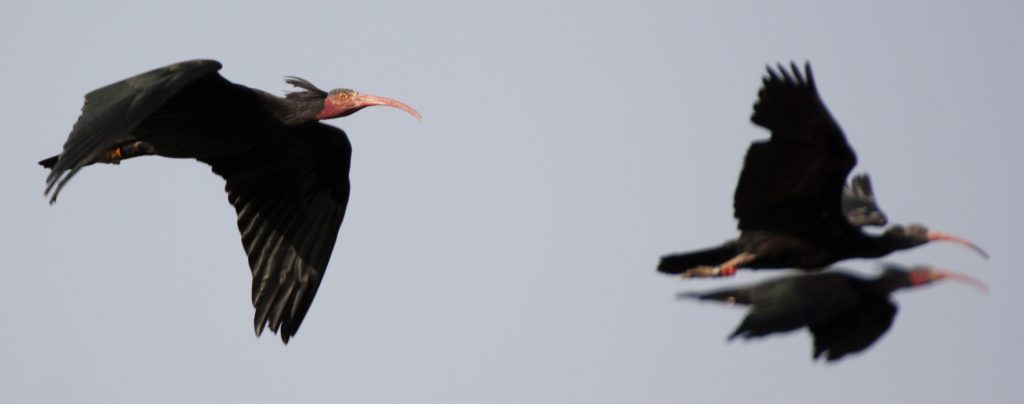
Twenty bird species occurring in Turkey are threatened with extinction at the global scale. These include the Critically Endangered (CR) Northern Bald Ibis, living in southeastern Turkey, Birecik.
Located at the junction of three continents, Asia, Africa and Europe, Turkey hosts an exceptionally rich and diverse avifauna. 485 bird species are recorded, of which at least 370 occur regularly. This accounts for approximately 70 percent of European bird species. The country is also of importance for several Middle Eastern or Oriental species, which find the northern-most margins of their range in Anatolia.
Three of world’s most significant bottleneck areas for soaring birds are located in Turkey. Bosphorus (Istanbul), Eastern Black Sea Mountains (including the Çoruh Valley) and Amanos Mountains (includes the Belen Pass) are these three key concentration areas. Myriads of soaring birds use these precious bottlenecks of Anatolia twice every year. In Istanbul, more than 20 million people share their province with tens of thousands of soaring birds twice a year. For instance, in autumn 2014, more than 45.000 Lesser Spotted Eagles, >30.000 Honey Buzzards, >25.000 Steppe Buzzards, and >9000 Short-toed Snake Eagles. Recent studies show that more than ninety-five percent of world’s Lesser Spotted Eagle and White Stork populations use Turkey during migration from Europe to Africa and vica versa. Thousands of Black Storks, White Pelicans, and other soaring birds are regularly counted along Turkey’s flyways, forming overwhelming proportions of these species’ European and global populations.
Turkey is not only important for migratory birds but also for several threatened species surviving in diverse and unique landscapes of Anatolia and Thrace. Twenty bird species occurring in Turkey are threatened with extinction at the global scale. These include the Critically Endangered (CR) Northern Bald Ibis and the Sociable Lapwing. For both, the grasslands in southeast Turkey are of critical importance. Four other bird species are classified as Endangered (EN). Among these, Egyptian Vulture and White-headed Duck have globally significant populations in Turkey. Up to 25 percent of the global population of Egyptian Vulture breeds in Anatolia and, up to 68 percent of world’s White-headed Ducks winter in lakes of Western Turkey. Two other species classified as EN, Steppe Eagle and Saker Falcon are confined to steppes of the Anatolian plateau. Central Anatolian steppes are recently identified as a key breeding region for Steppe Eagle.
Thirteen globally threatened species listed as Vulnerable (VU) occur in Turkey. For some of these, Turkey has high conservation value including the Common Pochard, Dalmatian Pelican, Yelkouan Shearwater, Eastern Imperial Eagle, Great Bustard and the European Turtle Dove. For example, Bosporus and Dardanelles are globally important migratory bottlenecks for the Yelkouan Shearwater. Turkey has recently been identified as a highly important breeding region for the Eastern Imperial Eagle as a result of new surveys and conservation projects. Another Vulnerable species, the Velvet Scoter has a very highly isolated breeding population in northeast Anatolia, which is inadequately studied taxonomically and for conservation purposes. Less widespread Vulnerable species include the Greater Spotted Eagle and Lesser White Fronted Goose having small wintering populations in the western half of Turkey. The Houbara Bustard is recorded in central Turkey in December 2013, after more than hundred years. The status of this rare species in Turkey is not known.
North-east Turkey forms the south-western part of the Caucasus Endemic Bird Area, where two restricted-range species, the Caucasian Grouse and Mountain Chiffchaff have key populations.
Status of some disjunct bird populations in Turkey is inadequately known, both ecologically and taxonomically. These include the critically endangered Taurus Mountain population of Fish Owl, recently classified as a new species, Bubo (Ketupa) semenowi, although not widely recognized yet. Anatolian Mountain Crane (Grus grus archibaldi), the Velvet Scoters of East Anatolia, the Beyşehir Lake population of large gulls – currently described as a transition population between Yellow-legged Gull and Armenian Gull – and Taurus Mountains range of some other species correspond to these disjunct populations that are of taxonomic interest. Further studies on these unique populations are of conservation significance as most of these are threatened from extinction.
Building on scientific knowledge on Turkey’s birds, Doga developed a comprehensive conservation programme on monitoring and conservation of birds over the last 15 years. Doga’s bird conservation programme includes supporting the development of the birding community, leveraging bird conservation science through long-term monitoring programs, undertaking on-the-ground species conservation actions and conservation of IBAs and flyways.
Photograph: © Turan Çetin
